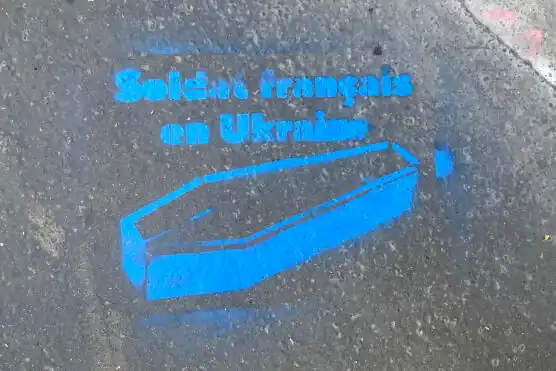In a city renowned for its art and culture, Parisians woke up to a startling sight: graffiti adorning the walls of buildings in the prestigious 7th arrondissement, echoing the enigmatic display of coffins left at the iconic Eiffel Tower.
The new symbols, discovered on June 7th, bear a chilling message, mirroring the sentiments of the controversial coffins: “French soldiers in Ukraine.”
The saga began on June 1st, when three individuals of varying nationalities—Bulgarian, German, and Ukrainian—were apprehended at the base of the Eiffel Tower, their actions raising suspicions of potential links to Russian interference.
Their arrest came in the wake of a similar incident involving red hands painted on the Wall of the Righteous at the Shoah Memorial, further fueling concerns of orchestrated destabilization efforts targeting France.
As investigators delved deeper into the matter, connections emerged between the individuals behind the Eiffel Tower coffins and those responsible for the previous graffiti.
The pieces fell into place when an obscure Ukrainian art collective, identifying themselves as “Mriya,” meaning “peace” in Ukrainian, reached out to media outlets including Le Monde, claiming responsibility for the provocative display.
Presenting the act as a “call for peace” amidst ongoing conflict, a spokesperson named Marina, purportedly residing in a European city, shed light on the motivations behind the gesture.
The group’s intention, she asserted, was to draw attention to the futility of war, denouncing it as a tool that serves only the interests of oligarchs.
Photos and videos provided by Marina showcased the coffins prior to their installation, revealing a meticulously planned operation with a significant financial investment.
Despite Marina’s assertions of independence from Russian influence, skepticism lingers, compounded by her refusal to disclose her identity and the group’s evasion of direct questioning.
While denying any involvement with previous graffiti incidents, the Ukrainian collective’s actions have reignited debates surrounding the extent of foreign interference in French affairs.
The implications of these events extend beyond mere vandalism, sparking diplomatic tensions and prompting introspection on national security measures.
With France already grappling with internal divisions and external pressures, the emergence of clandestine groups wielding symbolism as a form of protest underscores the fragility of societal cohesion in an increasingly interconnected world.
In response to these developments, authorities remain vigilant, striving to decipher the true intentions behind such displays while safeguarding the principles of freedom of expression.
As the investigation unfolds, questions persist regarding the role of foreign actors in shaping the narrative of dissent and the potential ramifications for diplomatic relations.
In the heart of Paris, where art and politics converge, the specter of uncertainty looms large, challenging the city’s reputation as a bastion of creativity and enlightenment.
As Parisians confront the aftermath of this brazen act of defiance, the echoes of coffins at the Eiffel Tower serve as a haunting reminder of the complexities inherent in the pursuit of peace amidst geopolitical turmoil.
This article was created using automation technology and was thoroughly edited and fact-checked by one of our editorial staff members



